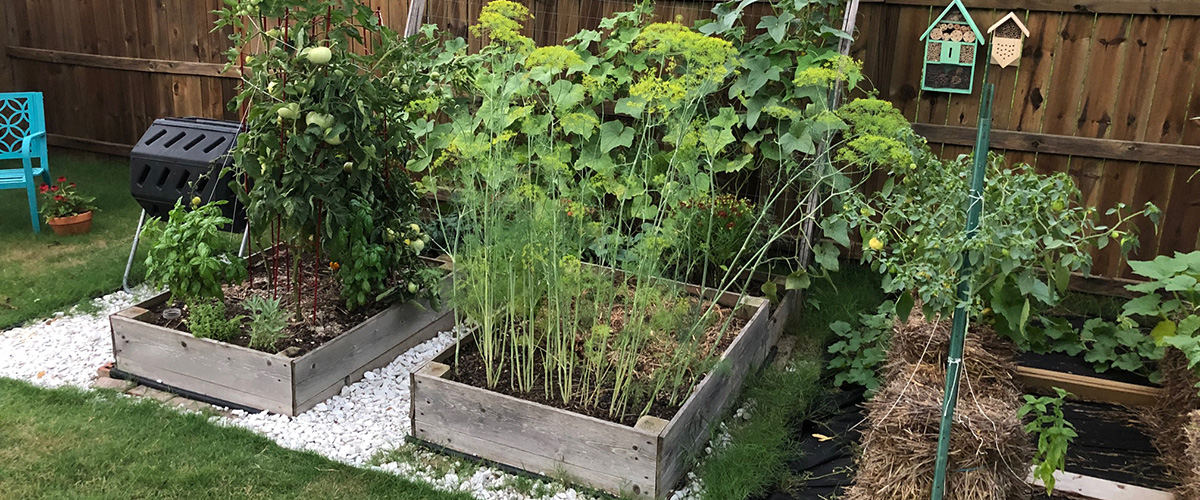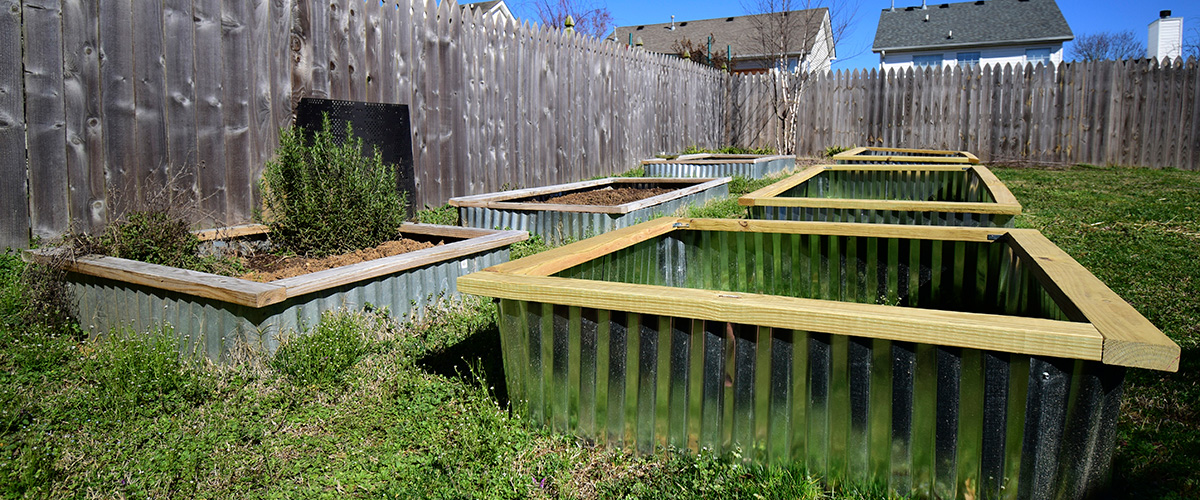Let me peer into my crystal ball and conjure a vision of your garden site: poor soil, bad drainage, limited space, lack of nutrients. While raised beds aren’t a magic bullet, they will likely help you address several of the common problems that gardeners encounter.
First, let’s take a look at exactly what a raised bed garden entails. At its essence, a raised bed is just an elevated area of soil used for planting vegetables, herbs, flowers, and other plants. The raised area of conditioned soil enables the gardener to make up for many of the deficits mentioned above by adding organic matter, fertilizer and other amendments.

WCMGA gardeners Matt and Kristy incorporate raised beds and other garden styles to produce vegetables and herbs in their back yard.
To overcome the erosion that will naturally reduce this simple style of raised bed to a “not-so-raised bed,” most gardeners employ some sort of structure. This can be most any material, but many choose wood, stone, metal, or cinder blocks. When dreaming up your raised bed garden plans, you’ll want to consider budget and aesthetics when picking a material. Wooden structure is particularly common, but the wood will degrade over time. Naturally weather-resistent woods are beautiful but expensive. Pressure-treated lumber is significantly cheaper (and often available for free if someone in the neighborhood is pulling apart an old deck), but there are concerns about the chemicals used in the process. (When researching this or any other gardening topic on the Internet, be sure to obtain information from a trusted source. Here's an article from the fine folks at the Iowa State Ag Extension: https://www.extension.iastate.edu/smallfarms/toxicity-concerns-about-raised-bed-construction-materials)
Cinder blocks aren't the most attractive material for raised bed gardening, but the openings inside the blocks can be used for a unique secondary growing space. Out at Franklin First United Methodist Church’s Giving Garden, they plant garlic, carrots, and more in the voids of the blocks that outline their raised bed gardens.
On the other end of the style/budget gardening matrix, there are a number of beautiful (but expensive) solutions to be had for the gardener dreaming of raised beds. Gardener's Supply Company has a variety of wonderful options listed here.
If you take your raised bed to the next level (all puns intended), you can have a garden that opens the horticultural world to people with disabilities. The bending, stooping, and kneeling that gardening often entails can be a barrier for folks who otherwise would gain enormous joy from gardening. Raised beds that are at sitting or standing height enable access for all. And even for people without disabilities, especially children, raising the growing medium off the ground and getting the produce closer to eye level changes the perspective and can spark true passion for plants. Here’s a quick how-to guide for raising this type of garden.

In the author’s backyard garden, DIY raised beds made from corrugated metal and wood provide the structure for a bounty of vegetables.
Personally, I appreciate the aesthetic of corrugated metal, and I love a good DIY project, so I built my raised beds from corrugated metal and wood. If you're curious about my process, you can read more here.
When situating your raised beds, you want to be conscious of the space between your beds. You’ll want to have enough space to get in and around -- between the beds, but also between any other structure and plants. Personally, I put my beds a little too close to my backyard fence, and getting the mower in there is a little dicey. With the wisdom of experience, I would have sacrificed just a little more lawn space and allowed some more room.
Got your ideal raise bed envisioned? Great, now let’s put it in! I trust you’ve chosen a proper site with appropriate sun for what you want to grow. In my backyard, I chose the sunniest spot I could find for the vegetables I wanted to grow. Plenty of publications, including the UT Extension publication on raised beds (SP291-N), recommend double digging your bed location. For my setup, I dug the depth of one shovel and worked in a lot of bagged garden soil and composted manure. If drainage on your site allows, another great way to get extra depth is to dig soil from the pathways in between your beds. As I do more and more in my garden, I always have extra dirt that I’ve removed, and I add it into my raised beds.
One tip for site prep: if you don’t kill the existing grass and weeds in your raised bed location, you’ll be pulling weeds for a while. I’ve installed beds without addressing the existing grass, and I’ve installed them after using black plastic to smother the underlying growth. Let’s just say I pick a lot more weeds out of one than the other. Also, if you have grass that’s worth preserving, you can cut sod with your spade and transplant it to other areas of the yard.
So let’s check our progress: beds built and installed, soil conditioned, and ready to grow!
When it comes to planting your brand new beds, less is more. It’s really easy to overcrowd and plant too much. Learn from my experience: your plants will probably grow bigger than you expect, and in a raised bed setting, that can reduce airflow and increase vulnerability to disease. A great resource for ideas and inspiration is the Square Foot Gardening Foundation. Square foot gardening is a method that’s been around for a while, and it’s popular enough that you can check out square foot gardening books at your local library. Just search for your main man Mel Bartholomew.

The man, the myth, the legend: Mel Bartholomew. His square foot gardening method has inspired millions of gardeners since the mid-90s. Source:
https://squarefootgardening.org.
Other considerations for new raised bed gardeners? Due to the raised nature of your new beds, they warm up sooner in winter and also dry out faster in summer. That means you’ll want a good layer of mulch to level out the extremes. Like any garden, you’ll need a water source, and the semi-permanent nature of raised beds makes them perfect for irrigation.
Cheers to raised expectations and raised beds – may your new space produce joy for years to come!
Here are some additional resources to check out:
The Tennessee Vegetable Garden: Building and Using Raised Beds (W346-E)
Raised Bed Gardening SP291-N University of Tennessee Agriculture Extension Service
Raised Bed Gardening - University of Missouri Extension
Preparing New Garden Beds - University of Connecticut Cooperative Extension System
How to build a Raised Bed Vegetable Garden - University of Maryland Extension
Types of Raised Beds - University of Maryland Extension (video)
Square Foot Gardening Foundation
This Old House: How to build a wheelchair-accessible raised bed garden (Video)